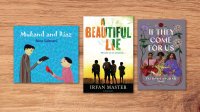How to Teach Students About the Partition of India and Pakistan
Books, videos, and other resources teachers can use with students in grades 3 to 12 to examine one of the largest mass migrations in history.
Your content has been saved!
Go to My Saved Content.One out of every five people on the planet lives in South Asia, which comprises Afghanistan, Bangladesh, Bhutan, India, Maldives, Nepal, Pakistan, and Sri Lanka, and about 5.4 million people of South Asian descent live in the United States. Very few educators, however, know or teach about Partition, which after 300 years of British economic intervention and, later, political domination formed the new nations of India and Pakistan in August 1947. Pakistan was divided into East and West Pakistan; East Pakistan later fought for its independence and became the nation of Bangladesh in 1971. From 1946 to 1948, an estimated 14 million people migrated, and 1 million to 2 million were killed.
The following texts and resources present, in age-appropriate ways, nuanced perspectives on this significant world historical event with legacies that linger today in the divisions and intergenerational trauma it cemented both on the South Asian subcontinent and within the diaspora.
Upper Elementary (Grades 3–5)
The following three picture books are best geared to the upper elementary level, given that they hint at the conflict and violence that engulfed this period.
Chachaji’s Cup, by Uma Krishnaswami, illustrated by Soumya Sitaraman (educator guide here), is the story of an Indian-American boy and his grand-uncle, whose special teacup is the only item that the elder still has from his childhood home. There’s also a brief history of Partition to share with students as well.
Mukand and Riaz, by Nina Sabnani (animated video of the book here), is set in 1947 and tells the story of two boys (Mukand and Riaz) who enjoy playing together. When the news of Partition comes, they must say farewell to each other, and Riaz helps Mukand and his family depart for India safely.
The Moon from Dehradun, by Shirin Shamsi, illustrated by Tarun Lak, is a forthcoming (2022) picture book about a young girl who has to leave her favorite doll behind when her family migrates to Pakistan during Partition.
Middle School (Grades 6–8)
The following two books, which teachers can use at the middle or high school level, offer deeply engaging narratives of individuals and communities during the Partition period.
The Night Diary, by Veera Hiranandani (educator guide here), won the Newbery Honor in 2019; it tells the story of a 12-year-old girl, Nisha, who has a Hindu father and a deceased Muslim mother. Nisha recounts her family’s refugee journey during Partition through a series of letters to her mother.
A Beautiful Lie, by Irfan Master (educator guide here), is a young adult novel set in 1947 during the weeks before Partition. Thirteen-year-old Bilal, a Muslim boy in India, devises an elaborate plot with his friends to keep the news of Partition and its related violence from his dying father, who would find it heartbreaking.
High School (Grades 9–12)
There are several ways to engage high school students in discussing Partition. The following activities align with the emphasis in Common Core on the use of primary sources (Reading Standards 5 and 7 for Literacy in History/Social Studies) as well as most state standards for world history that include 20th-century decolonization movements and Unit 8 in the AP World History (Modern) curriculum, which covers how “colonies in Asia and Africa achieved independence.”
Each of the activities below can build on one another in the suggested sequence, or students can utilize them individually.
1. Watch and discuss a video: This six-minute video from TED-Ed, “Why Was India Split Into Two Countries?” presents an accessible discussion of the basic foundations of Partition. In the three-minute video “Partition of India: One Woman’s Incredible Story,” a woman narrates her story of fleeing with her children during the violence and chaos of Partition.
2. Engage with an archive: The 1947 Partition Archive is a treasure trove of information, with nearly 10,000 oral histories of individuals who survived Partition. An interactive map on its webpage helps students locate stories, explore migration routes, and read summaries of survivors who migrated in different directions. This New York Times article (and video) about the archive, as well as the archive’s YouTube channel, can also be useful for students.
3. Take a virtual museum visit: Have students take a virtual tour of the Partition Museum in Amritsar, India, or the Kolkata Partition Museum and explore online images of collection items, videos, and articles, such as this one from the BBC. Separately, students can explore this series of images of Partition from American photographer Margaret Bourke-White.
4. Read and write poetry: Poetry offers a way to understand the deeply felt traumas of Partition and their legacies. Students can read a few poems such as “Partition” and “They Asked for a Map” in Fatimah Asghar’s book If They Come for Us and the verses on pages 64–65 about Partition in Gayatri Sethi’s book Unbelonging. Students can then write poems individually or in small groups from the perspective of a Partition refugee, or about any related theme in their own family histories pertaining to exclusion, migration, conflict, or displacement.
The additional selected curricula, books, and articles below offer further analyses of Partition and its legacies:
- “Partition in the Classroom: Differentiated Strategies for Teaching India’s Partition,” curriculum from the University of Texas
- The 1947 Partition Archive’s extensive lists of films and books on their website
- “The Great Divide,” article in The New Yorker
- “How the Partition of India Happened,” article in The Conversation
- “Young Indians and Pakistanis Rewrite Their Shared History,” article from NPR
- “From Postmemory to Post-Amnesia: Remembering and Forgetting East Pakistan,” article in The Daily Star
